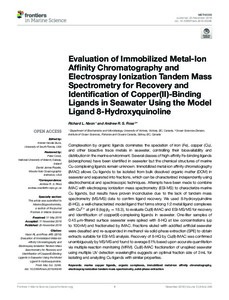| dc.contributor.author | Nixon, Richard L. | |
| dc.contributor.author | Ross, Andrew R.S | |
| dc.date.accessioned | 2019-01-08T15:34:20Z | |
| dc.date.available | 2019-01-08T15:34:20Z | |
| dc.date.issued | 2016 | |
| dc.identifier.citation | Nixon, R.L. and Ross, A.R.S. (2016) Evaluation ofImmobilizedMetal-Ion Affinity Chromatography and Electrospray Ionization Tandem Mass Spectrometry for Recovery and Identification ofCopper(II)-Binding Ligands ineawater using the model
Ligand 8-Hydroxyquinoline. Frontiers in Marine Scoence, 3:246, 10pp.. DOI: 10.3389/fmars.2016.00246 | en_US |
| dc.identifier.uri | http://hdl.handle.net/11329/637 | |
| dc.identifier.uri | http://dx.doi.org/10.25607/OBP-196 | |
| dc.description.abstract | Complexation by organic ligands dominates the speciation of iron (Fe), copper (Cu), and other bioactive trace metals in seawater, controlling their bioavailability and distribution in the marine environment. Several classes of high-affinity Fe-binding ligands (siderophores) have been identified in seawater but the chemical structures of marine Cu-complexing ligands remain unknown. Immobilized metal-ion affinity chromatography (IMAC) allows Cu ligands to be isolated from bulk dissolved organic matter (DOM) in seawater and separated into fractions, which can be characterized independently using electrochemical and spectroscopic techniques. Attempts have been made to combine IMAC with electrospray ionization mass spectrometry (ESI-MS) to characterize marine Cu ligands, but results have proven inconclusive due to the lack of tandem mass spectrometry (MS/MS) data to confirm ligand recovery. We used 8-hydroxyquinoline (8-HQ), a well-characterized model ligand that forms strong 1:2 metal:ligand complexes with Cu2+ at pH 8 (log β2 = 18.3), to evaluate Cu(II)-IMAC and ESI-MS/MS for recovery and identification of copper(II)-complexing ligands in seawater. One-liter samples of 0.45 μm-filtered surface seawater were spiked with 8-HQ at low concentrations (up to 100 nM) and fractionated by IMAC. Fractions eluted with acidified artificial seawater were desalted and re-suspended in methanol via solid-phase extraction (SPE) to obtain extracts suitable for ESI-MS analysis. Recovery of 8-HQ by Cu(II)-IMAC was confirmed unambiguously by MS/MS and found to average 81% based upon accurate quantitation via multiple reaction monitoring (MRM). Cu(II)-IMAC fractionation of unspiked seawater using multiple UV detection wavelengths suggests an optimal fraction size of 2 mL for isolating and analyzing Cu ligands with similar properties. | en_US |
| dc.language.iso | en | en_US |
| dc.rights | Attribution 4.0 | * |
| dc.rights.uri | http://creativecommons.org/licenses/by/4.0/ | * |
| dc.subject.other | Copper | en_US |
| dc.subject.other | Organic ligands | en_US |
| dc.subject.other | Organic complexes | en_US |
| dc.subject.other | Immobilized metal-ion affinity chromatography | en_US |
| dc.subject.other | Electrospray ionization tandem mass spectrometry | en_US |
| dc.subject.other | Solid-phase extraction | en_US |
| dc.title | Evaluation of Immobilized Metal-Ion Affinity Chromatography and Electrospray Ionization Tandem Mass Spectrometry for Recovery and Identification of Copper(II)-Binding Ligands in Seawater Using the Model Ligand 8-Hydroxyquinoline. | en_US |
| dc.type | Journal Contribution | en_US |
| dc.description.refereed | Refereed | en_US |
| dc.format.pagerange | 10pp. | en_US |
| dc.identifier.doi | 10.3389/fmars.2016.00246 | |
| dc.subject.parameterDiscipline | Parameter Discipline::Chemical oceanography::Metal and metalloid concentrations | en_US |
| dc.bibliographicCitation.title | Frontiers in Marine Science | en_US |
| dc.bibliographicCitation.volume | 3 | en_US |
| dc.bibliographicCitation.issue | Article 246 | en_US |
| dc.description.bptype | Best Practice | en_US |
| dc.description.bptype | Standard Operating Procedure | en_US |
| dc.description.frontiers | 2016-05-31 | |
| obps.contact.contactemail | andrew.ross@dfo-mpo.gc.ca | |
| obps.resourceurl.publisher | https://www.frontiersin.org/articles/10.3389/fmars.2016.00246/full | en_US |
 Repository of community practices in Ocean Research, Applications and Data/Information Management
Repository of community practices in Ocean Research, Applications and Data/Information Management

